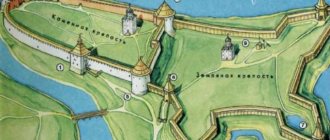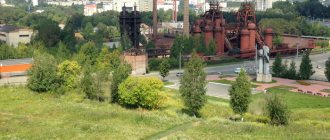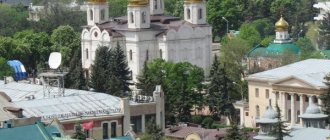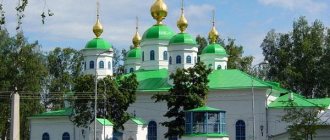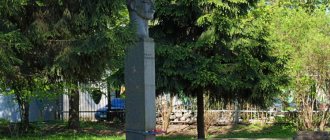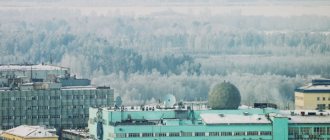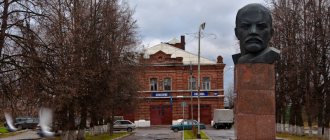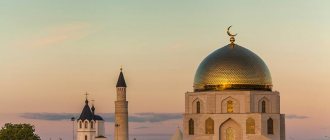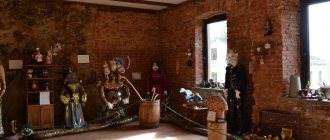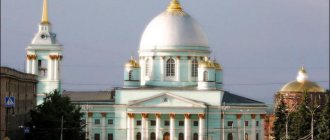Staraya Ladoga traces its history back to the 7th century. Situated at the intersection of two great trade routes, it has attracted artisans and merchants since ancient times. It was in Ladoga that the first Varangian prince Rurik, who stood at the origins of the Old Russian state, settled.
Today, on the site of this ancient trade and craft settlement, the Staraya Ladoga Museum-Reserve has been formed, welcoming everyone.
Not far from the village there is a rather interesting city - Novaya Ladoga, which is worth visiting if you are by car. Read about other interesting places in the Leningrad region in our review material about the environs of St. Petersburg.
Museum-Reserve "Old Ladoga"
Address: Leningrad region, p. Staraya Ladoga, Volkhovsky pr., 19 Telephone: ;; 8 (911) 272-27-50 Website: https://www.ladogamuseum.ru/ Opening hours: 09:00-17:00 Mon., 09:00-18:00 Tue.-Sun. Cost of a single entrance ticket: children under 16 years old – free; students, pensioners, disabled people – 80 rubles; persons over 18 years old – 150 rubles. How to get there: by car - along the E105 St. Petersburg - Petrozavodsk highway; by train - from Moskovsky or Ladozhsky railway stations to the Volkhovstroy station, then by bus No. 23 to the Staraya Ladoga stop.
This museum is not just halls with exhibits, it is, in fact, the entire old city, its historical buildings, fortress and churches. We will talk about them in more detail below.
The museum itself contains many exhibits of historical and architectural, everyday life, painting, and archeology of the area. You can find out about ongoing exhibitions on the museum's website.
Staraya Ladoga Fortress
Address: Leningrad region, p. Staraya Ladoga, Volkhovsky pr., 19 Telephone: ;; 8 (911) 272-27-50 Website: https://www.ladogamuseum.ru/ Opening hours: 09:00-17:00 Mon., 09:00-18:00 Tue.-Sun. Cost: children under 16 years old, veterans, university students - free, secondary vocational education students, pensioners, disabled people - 10 rubles, persons over 18 years old - 20 rubles. How to get there: by car - along the E105 St. Petersburg - Petrozavodsk highway; by train - from Moskovsky or Ladozhsky railway stations to the Volkhovstroy station, then by bus No. 23 to the Staraya Ladoga stop.
Staraya Ladoga, in addition to being a center of trade and crafts, was also an important maritime hub, which made it an important strategic object in the eyes of enemies. Therefore, the presence of a defensive structure became a necessity for this settlement.
According to archaeological excavations, the first fortress on the territory of Ladoga appeared in the 9th century, but the construction of the late 15th century has survived to this day.
The Staraya Ladoga Fortress is located in the place where the Ladozhka River flows into the Volkhov. Its stone walls come close to the water, which in the old days created an additional obstacle in the path of enemies. A lot of provisions and water were also always stored on the territory of the fortress in case of long-term defense.
The walls of this ancient fortress withstood countless attacks, protecting the northwestern borders of the Russian state from enemy raids. Fortunately, today there is no need to storm the impregnable Ladoga, its gates are open for free visits.
Church of St. George
Address: Leningrad region, p. Staraya Ladoga, Volkhovsky pr., 19 Telephone: ;; 8 (911) 272-27-50 Website: https://www.ladogamuseum.ru/ Opening hours: 09:00-17:00 Mon., 09:00-18:00 Tue.-Sun. Cost: children under 16 years old, veterans, university students - free, secondary vocational students, pensioners, disabled people - 50 rubles, persons over 18 years old - 80 rubles. How to get there: by car - along the E105 St. Petersburg - Petrozavodsk highway; by train - from Moskovsky or Ladozhsky railway stations to the Volkhovstroy station, then by bus No. 23 to the Staraya Ladoga stop.
The church in the name of the Holy Great Martyr George the Victorious was built in the 12th century in honor of the victory over the Swedish army on the Voronega River. Its architecture reflects the traditions of both Byzantine and Novgorod temple architecture.
There is a belief that here in 1240, before the battle with the Swedes, Prince Alexander Yaroslavovich, later nicknamed Nevsky for that victory, prayed with his retinue.
Today, St. George's Church is ranked among the monuments of world culture and is included in the UNESCO World Heritage Register. The temple is considered a museum of one fresco, “The Miracle of George on the Serpent,” the oldest image of St. George the Victorious that has survived to this day. There are no services held in the church.
Church of Demetrius of Thessalonica
Address: Leningrad region, p. Staraya Ladoga, Volkhovsky pr., 19 Telephone: ;; 8 (911) 272-27-50 Website: https://www.ladogamuseum.ru/ Opening hours: 09:00-17:00 Mon., 09:00-18:00 Tue.-Sun. Cost of a single entrance ticket: children under 16 years old – free; students, pensioners, disabled people – 80 rubles; persons over 18 years old – 150 rubles. How to get there: by car - along the E105 St. Petersburg - Petrozavodsk highway; by train - from Moskovsky or Ladozhsky railway stations to the Volkhovstroy station, then by bus No. 23 to the Staraya Ladoga stop.
Walking outside the walls of the ancient fortress, you can see another unique religious structure - the Church of Demetrius of Thessalonica. It was built in the 17th century and was originally used as a warm winter church at the Church of St. George. Several times the church was dismantled and exact copies were erected, as the previous buildings fell into disrepair. A copy from the early twentieth century has survived to this day.
Today the church houses a local history museum, where you can get acquainted with objects of peasant life and the internal structure of the temple.
Zemlyanoy city
Address: Leningrad region, p. Staraya Ladoga, Volkhovsky pr., 19 Telephone: ;; 8 (911) 272-27-50 Website: https://www.ladogamuseum.ru/ Opening hours: 09:00-17:00 Mon., 09:00-18:00 Tue.-Sun. Cost of a single entrance ticket: children under 16 years old – free; students, pensioners, disabled people – 80 rubles; persons over 18 years old – 150 rubles. How to get there: by car - along the E105 St. Petersburg - Petrozavodsk highway; by train - from Moskovsky or Ladozhsky railway stations to the Volkhovstroy station, then by bus No. 23 to the Staraya Ladoga stop.
On the territory of the museum there is a unique historical monument “Earth City”. This is one of the first wooden-earth bastion fortifications in Russia. Presumably, these earthworks were built in the 16th century on the orders of Boris Godunov. Until the eighteenth century, the “Earth City” and the Staraya Ladoga Fortress protected the entire northwestern Rus'.
Church of the Nativity of John the Baptist on Malysheva Hill
Address: Leningrad region, p. Staraya Ladoga, st. Pozemskaya, 1. Phone: 8 (263) 49-397 Opening hours: 09:00-19:00 Mon.-Sun. Cost: free How to get there: by car - along the E105 St. Petersburg - Petrozavodsk highway; by train - from Moskovsky or Ladozhsky railway stations to the Volkhovstroy station, then by bus No. 23 to the Staraya Ladoga stop.
On Malysheva Hill, which is located on the very outskirts of the village, stands the Church of the Nativity of John the Baptist, dating back to the distant sixteenth century.
Just a few years ago, the temple was threatened with complete destruction. It turned out that Malysheva Mountain was pitted from the inside with underground passages that were dug by local residents. In the 19th century, peasants mined quartz sand in this place, which was sold to the Northern capital for the manufacture of light bulbs. However, the former enterprise almost resulted in the loss of a unique historical monument. Restorers had to fill the voids in the mountain with concrete to prevent destruction.
Church of Alexy, man of God
Address: Leningrad region, p. Staraya Ladoga, at the cemetery of the Staraya Ladoga Assumption Monastery Opening hours: 09:00 – 19:00 Mon.-Sun. Cost: free How to get there: by car - along the E105 St. Petersburg - Petrozavodsk highway; by train - from Moskovsky or Ladozhsky railway stations to the Volkhovstroy station, then by bus No. 23 to the Staraya Ladoga stop.
In the first half of the nineteenth century, parishioners of the Assumption Monastery, using their own donations, built a small wooden chapel and consecrated it in the name of Alexei, the man of God. A few years later, St. Petersburg businessman Semyon Kalinin allocated funds for the construction of a stone temple. So in 1833 the construction of the modern church began. By the way, the temple later became the main source of income for the Assumption Monastery!
Then, like most domestic shrines, the temple fell on hard times, but it survived, and in 2000 it was completely restored with funds from a local enterprise.
Church of the Transfiguration
Address: Leningrad region, p. Old Ladoga Cost: free How to get there: by car - along the E105 St. Petersburg - Petrozavodsk highway; by train - from Moskovsky or Ladozhsky railway stations to the Volkhovstroy station, then by bus No. 23 to the Staraya Ladoga stop.
In 1684, a wooden Transfiguration Church was built next to the Vasilyevsky Monastery on the right bank of the Volkhov River. It was erected under the strict supervision of Tsar Fyodor Alekseevich himself, but the shrine stood in its original appearance only until the second half of the nineteenth century. A strong fire destroyed the building, and in its place in 1871, with donations from the merchant Rybin, a new stone temple was erected.
Vasilyevsky Pogost with the Church of St. Basil of Caesarea
Address: Leningrad region, Chernavino village Opening hours: 09:00 – 19:00, Mon.-Sun. Cost: free How to get there: by car - along the E105 St. Petersburg - Petrozavodsk highway; by train - from Moskovsky or Ladozhsky railway stations to the Volkhovstroy station, then by bus No. 23 to the Chernavino stop
If you cross to the right bank of the Volkhov, be sure to visit the village of Chernavino, where the amazing pillarless temple of St. Basil of Caesarea stands. Later, a monastery arose around the cathedral, but the local brethren constantly experienced great need, poverty and deprivation. All this led to the fact that in the middle of the seventeenth century the stone temple on the territory of the monastery was destroyed to the ground. Only after this incident, at the expense of the local governor, a new stone church with a refectory was built.
Recently the temple was restored again and is now open to the public.
Nikolsky Monastery
Address: Leningrad region, p. Staraya Ladoga, st. Nikolskaya, 1 Opening hours: 09:00 – 17:00 Mon.-Sun. Cost: free How to get there: by car - along the E105 St. Petersburg - Petrozavodsk highway; by train - from Moskovsky or Ladozhsky railway stations to the Volkhovstroy station, then by bus No. 23 to the Staraya Ladoga stop.
Truly amazing buildings can be found on the territory of the Nikolsky Monastery. Here the seventeenth-century tented bell tower is adjacent to the amazingly beautiful Church of St. John Chrysostom, built two centuries later. However, the most attractive building of the monastery is considered to be the St. Nicholas Cathedral, the history of which goes back to the distant twelfth century.
One of the legends says that the St. Nicholas Monastery was created on the occasion of the victory over the Swedes in the Battle of the Neva, in which Ladoga residents also took part. But this fact is not documented anywhere, so it’s up to you to believe it or not.
Varyazhskaya street
Address: Leningrad region, p. Staraya Ladoga, st. Varyazhskaya
A good tradition for all guests of Staraya Ladoga is a walk along Varyazhskaya Street, the oldest street in Russia. The first mentions of it date back to the 15th century, although at that time the location of the street was different - it ran perpendicular to the modern road. Varyazhskaya Street became famous after archaeologists found unique objects on its territory dating back to the 9th-10th centuries. This made it possible to put forward an assumption about such a significant age of this place.
Falcon sculpture
Address: Leningrad region, p. Staraya Ladoga, st. Varyazhskaya
At the beginning of Varyazhskaya Street there is a monument to a hunting falcon, personifying the unity of local residents and nature. The image of this noble bird can also be seen on the coat of arms of the Staraya Ladoga settlement.
Despite the fact that the monument was erected quite recently, in 2013, it already has its own tradition: you need to leave a coin in the falcon’s beak or feathers, which promises happiness and good luck
.
Stone Chapel
Address: Leningrad region, p. Staraya Ladoga, st. Varangian Cost: free
Walking along this quiet and cozy village street, it is impossible to pass by the Stone Chapel, built in 1913 with funds from the Imperial Geographical Society. The initiator of the construction was archaeologist N.E. Brandenburg, who proposed to erect a new shrine on the site of the 12th century church, since only one foundation remained from the previous one.
Kalyazin houses
Address: Leningrad region, p. Staraya Ladoga, st. Varyazhskaya Opening hours: 09:00-17:00 Mon-Sun. Cost: from 150 rub. How to get there: by car - along the E105 St. Petersburg - Petrozavodsk highway; by train - from Moskovsky or Ladozhsky railway stations to the Volkhovstroy station, then by bus No. 23 to the Staraya Ladoga stop.
On Varyazhskaya Street there are also famous merchant houses that once belonged to the Kalyazin family. Currently in a wooden house, owned by A.V. Kalyazin, there is a museum of merchant life, introducing tourists to the life of a merchant family of the 19th-20th centuries.
The second house belonged to P.V. Kalyazin and was built from Eliseevsky brick. The first floor of the house was once occupied by a store that mainly sold food products. The merchant's family lived on the second floor. Today the building houses the exhibition “Archaeology of Ladoga”.
Monument to Rurik and Prophetic Oleg
Address: Leningrad region, p. Staraya Ladoga, st. Varyazhskaya
In 2015, a monument to the founders of the ancient Russian state, princes Rurik and Oleg the Prophet, was unveiled. The statue symbolizes the beginning of the emergence of Russian statehood, and is unique, since nowhere else in our country is there a single monument dedicated to these great founders.
Assumption Monastery
Address: Leningrad region, p. Staraya Ladoga, Uspensky lane. Phone: Website: https://uspenie-ladoga.ru/ Opening hours: 09:00-19:00 Mon.-Sun. Cost: free How to get there: by car - along the E105 St. Petersburg - Petrozavodsk highway; by train - from Moskovsky or Ladozhsky railway stations to the Volkhovstroy station, then by bus No. 23 to the Staraya Ladoga stop.
Varyazhskaya Street closes with the famous Assumption Monastery, which became famous primarily as a place of imprisonment for many eminent women. At one time, Evdokia Lopukhina, the first wife of Peter I, who in monasticism received the name Elena, became his prisoner. For seven long years she languished within the walls of the monastery, until the emperor’s death. During the period of imprisonment of such a high person, the monastery was closed to parishioners, and a military guard was constantly on duty around it. These places forever preserved the memory of the unfortunate woman, so from those times the Ladozhka River began to be called Elena, and the embankment received the same name.
When visiting the monastery, you should pay special attention to visiting the Cathedral of the Dormition of the Blessed Virgin Mary, which is one of the few surviving monuments of pre-Mongol Rus'.
Uspenskoye Estate
Address: Leningrad region, p. Old Ladoga, near the Assumption Monastery Cost: free How to get there: by car - along the E105 highway St. Petersburg - Petrozavodsk; by train - from Moskovsky or Ladozhsky railway stations to the Volkhovstroy station, then by bus No. 23 to the Staraya Ladoga stop.
Adjacent to the Assumption Monastery is the estate of the same name, which once belonged to the art connoisseur and philanthropist A.R. Tomilov. It was under him that the estate reached its peak and became a cultural center for the entire north-west. In the 19th century, many famous artists stayed here for a long time: I.K. Aivazovsky, O.A. Kiprensky, A.G. Venetsianov and others. Tomilov also collected a valuable collection of drawings, among which were etchings by Rembrandt.
In 1918, when the Bolsheviks came to power, the estate was confiscated, and all the paintings and drawings were transferred to the Russian Museum.
Today the territory of the estate is open to free visits. Many tourists, after a busy excursion program, like to stroll along the park alleys of this famous estate. Unfortunately, the entrance to the building is closed.
Tract "Pobedishche"
Address: Leningrad region, p. Old Ladoga, near the St. Nicholas Monastery Cost: free How to get there: by car - along the E105 highway St. Petersburg - Petrozavodsk; by train - from Moskovsky or Ladozhsky railway stations to the Volkhovstroy station, then by bus No. 23 to the Staraya Ladoga stop.
On the southernmost outskirts of Staraya Ladoga there is the Pobedishche tract, which dates back several centuries. Presumably the first burials date back to the 8th century! This place was first discovered by the famous geographer N.E. Brandenburg, who excavated hill No. 140.
The Bloody Stream flows not far from the tract. According to legend, a major battle with the Swedes once took place in these places, which claimed the lives of many Ladoga residents. The blood of wounded and killed soldiers flowed down the stream into the waters of the Volkhov River. By the way, this legend may be true, since during excavations archaeologists discovered human and horse remains here, as well as rusted weapons.
Sopki tract
Address: Leningrad region, p. Old Ladoga, near the Church of John the Baptist Cost: free How to get there: by car - along the E105 St. Petersburg - Petrozavodsk highway; by train - from Moskovsky or Ladozhsky railway stations to the Volkhovstroy station, then by bus No. 23 to the Staraya Ladoga stop.
The Sopka tract is shrouded in secrets and legends, one of which says that the famous ancient Russian prince Oleg the Prophet, who united northern and southern Rus', is buried here. To this day, all the circumstances of his death are not known for certain, which gives rise to many guesses and assumptions. However, the northern version is considered the most plausible, indicating that Oleg the Prophet was buried in Ladoga.
In the first half of the 19th century, a group of scientists managed to discover human remains in one of the hills, but it is difficult to say whether they belong to this prominent historical figure, so debate on this issue continues to this day.
Settlement at the mouth of the Lyubsha River
Address: Leningrad region, p. Staraya Ladoga, 1.5 km northeast of Zemlyanoy Gorodishche Cost: free How to get there: by car - along the E105 St. Petersburg - Petrozavodsk highway; by train - from Moskovsky or Ladozhsky railway stations to the Volkhovstroy station, then by bus No. 23 to the Staraya Ladoga stop.
Perhaps one of the most mysterious places in Staraya Ladoga is the Lyubshan settlement. It was discovered relatively recently, in 1997. Archaeological finds allowed researchers to make a bold statement that the fortress located on this territory is the oldest in all of Rus'. The fortification was erected in the 7th century by local Slovenian tribes.
In the 9th century, the Lyubsha fortress was abandoned, as it lost its original defensive significance.
Stone fortress
The historical center of the settlement is the Stone Fortress, built in the 15th century. On the site of more ancient walls. The fortress stands in a strategically important place on Cape Volkhov and Ladozhka and is surrounded by water. The surviving walls were built during the era of gunpowder and are very solidly built. Their thickness reaches 7 meters. Height – up to 12 meters. There are 5 well-preserved towers up to 19 meters in height.
The ruins that stood here were nicknamed “Rurik Castle”. For a long time there have been legends about secret doors behind which a huge dungeon or even a passage under the Volkhov is hidden. There was talk of treasures and secret dungeons hiding the secrets of the past. However, upon detailed examination by archaeologists, it turned out that all these were just urban legends.
There were no underground passages in the fortress and towers. Although they searched carefully and dug them down to the very foundation. In the 1880s. the fortress had a sad and abandoned appearance: “Everywhere around there is a stamp of long-ago destruction: half-crumbled vaults, stone massifs threatening to fall instantly, the crests of walls and towers chewed by centuries, all this, in the midst of general silence, breathes death, breathes something long outdated; the impression is aggravated by the multitude of graves crosses of the local St. George's churchyard, occupying the interior of the fortress."
They began to save the historical heritage only in 1978 against the background of the then revival of interest in native history. According to the design of the restorer A.E. Eck, two were rebuilt: the Klimentovskaya and Vorotnaya towers with a spindle between them. During the work, archaeologists discovered two more fortresses of the 9th and 12th centuries. This made it possible to date the founding of Staraya Ladoga to at least 753.
The most striking event in the history of the fortress was the reign of Rurik here. However. He ruled here for a short time and soon moved to Veliky Novgorod - to the source of the river. The fortress remained an important trading outpost and reserve base for the Varangians. Here taxes were collected from traders and enemy troops were met.
Modern walls appeared in the 16th century. It should be noted that at this time the fortress did not have advanced military significance and was not a priority target. However, during the Time of Troubles, the Swedes still attacked it, destroying part of the walls. After the return of Staraya Ladoga, they planned to restore the city for a long time, so that it would not embarrass merchants and ambassadors passing through with its ruined appearance, but it never worked out.
Caves of Staraya Ladoga
Address: Leningrad region, p. Old Ladoga, near the Church of John the Baptist Cost: free How to get there: by car - along the E105 St. Petersburg - Petrozavodsk highway; by train - from Moskovsky or Ladozhsky railway stations to the Volkhovstroy station, then by bus No. 23 to the Staraya Ladoga stop.
Staraya Ladoga is famous not only for its historical sights. There are also real caves here! The dungeons were created by local residents who, at the end of the nineteenth century, mined quartz sand in the vicinity of the settlement. In the 20th century, the caves became of interest to scientists who examined the remains of fossilized animals here.
Today the caves are open to the public, but beginners are advised not to take risks and not go into the dungeons alone, as it is unsafe. It is better to go down into the caves as part of an excursion group or with an experienced guide!
Ladoga burial hills
The Ladoga burial mounds in the Sopki tract on the left bank of the Volkhov, behind the Church of the Nativity of John the Baptist, are a whole burial complex of the 8th-10th centuries. The center of the complex is a large ten-meter burial mound, which some scientists consider the burial mound of Prophetic Oleg. There is no exact information about the burial place of the second ruler of Rus', there are only sources that say that his last journey was made to Novgorod, and then to Ladoga.
There is a version that he was buried near Kiev on Mount Shchekovitsa, but given that the Scandinavian chronicles call the main city of Gardariki Holmsgard (Novgorod), the northern version is considered more plausible. In 1820, excavations were carried out here, which did not find rich burials on Oleg’s hill. However, the grave could have been robbed earlier. Based on the available finds, it is difficult to say anything definite about the burial, however, there is no refutation of the version about the prince’s grave.
In any case, this is a rather interesting historical monument. Probably, the mounds are not only burial places of the dead, but also unique commemoration complexes, where relatives of the buried gathered in order to reunite with their ancestors and pay tribute to their memory, as well as carry out other religious practices.
Gorchakovshchinsky waterfall
Address: Leningrad region, Gorchakovshchina village Cost: free How to get there: by car - along the E105 highway St. Petersburg - Petrozavodsk; by train - from Moskovsky or Ladozhsky railway stations to the Volkhovstroy station, then by bus No. 24, No. 28, No. 32, No. 53 to the Gorchakovshchina stop.
Gorchakovshchinsky waterfall is interesting because it is the highest waterfall in the Leningrad region. Its height reaches four meters. The waterfall is located on a small river flowing into the Volkhov. Therefore, if you have a couple of free hours, you can safely go to the village of Gorchakovshchina to enjoy the picturesque landscape and feel the peaceful atmosphere.
If you have not yet chosen where you will live and want to save money when booking, we recommend using the RoomGuru service. Firstly, it contains hotels, apartments and guest houses from many different booking systems, so you won’t miss out on a worthwhile option. Secondly, you can immediately compare prices for one place in different services and book where it is cheaper (this is not always Booking!).
Falcon sculpture
Near the entrance to the Staraya Ladoga Fortress, at the very beginning of Varangian Street, you can see the sculpture of a falcon - the symbol of Staraya Ladoga and the family coat of arms of Rurik, depicted on the shields and banners of his warriors. Nowadays the falcon is a symbol of the Staraya Ladoga settlement and the Volkhov region, as a tribute to history.
The statue is a bronze falcon on natural stone. The formidable bird seems to have spread its wings and is preparing to take off. This is a favorite attraction for tourists, who constantly take pictures with the statue and leave coins in its beak and claws as souvenirs.
The bronze bird appeared at this place in 2013 during the annual holiday - Days of the Leningrad Region.
Nikolsky Monastery
The foundation of the Nikolsky Monastery in 1240 was dedicated to the victorious battle of Alexander Nevsky with the Swedes on Lake Ladoga. The surviving census of 1628 says that the St. Nicholas Monastery had two churches - St. Nicholas the Wonderworker and St. John Chrysostom. They still form the basis of the monastery. St. Nicholas Church today appears in the form of a single-domed quadrangle, divided by vaults into 2 floors. One floor belongs directly to the church, and the second is a basement. The Church of St. John Chrysostom, erected on the site of a dilapidated temple in 1873, is notable for the paintings preserved on the vaults, arches and walls depicting scenes from the Gospel. The majestic bell tower was erected by architects from Tikhvin in the 90s of the 17th century.
The St. Nicholas Monastery became famous for finding in it a particle of the relics of St. Nicholas the Wonderworker, brought from Bari, and particles of the relics of St. Theodosius and Mary Magdalene, the healer Panteleimon, and several saints and great martyrs revered by Christians.
Reservoirs
The Leningrad region is rich in various reservoirs. The museum-reserve also has its own remarkable places.
Volkhov River
The village of Staraya Ladoga is located on the banks of the Volkhov River. The “culprit” of this name was one of the Scythian princes - Sloven. At first, of course, the name Magi (magician) was given to the tribes living on the shore.
View of Staraya Ladoga from the Volkhov River during sunset
At all times, the river was rich in fish. Today, tourists can not only go fishing, but also go boating along the difficult Volkhov riverbed.
Take note: tourists who are not afraid of difficulties can travel by boat along the route along which they sailed along the Volkhov River “from the Varangians to the Greeks.”
Staraya Ladoga Canal
The Staraya Ladoga Canal, 117 kilometers long, connects the Volkhov and Neva, while bypassing Lake Ladoga. The canal begins on the Volkhov River four kilometers from the mouth and leads to the Neva.
Staraya Ladoga Canal in the Leningrad Region. A cultural heritage site included in the UNESCO list - however, its condition does not correspond to its high status. Experts say that the monument is in danger of complete destruction. It has been impossible to clean or repair the canal for many years
Peter the Great himself began and supervised the construction of the canal, who took out three wheelbarrows of earth with his own hands. At the same time, the tsar gave freedom to every peasant who came to work, and this was in 1719. Construction was very difficult and proceeded slowly, ending only in 1731 during the reign of Anna Ioannovna, who broke through the earthen bridge with a shovel. These tools - a wheelbarrow and a shovel - were stored for a long time in a chapel built near the canal.
Ladoga lake
Lake Ladoga was called differently: “Little Sea”, “Lake of Life”, Ladoga. In ancient times, the lake bore the name Nevo, then it began to be called Ladoga after the name of the fortress.
Lake Ladoga is the largest lake in Europe. Our ancestors considered Ladoga a sea, and they called the Varangians precisely because of this sea, and not because of the Baltic Sea
The shores and waters of the lake have gone through many events. Archaeologists have been studying the bottom of the lake for decades and have found many historical artifacts.
This is the largest lake in Europe of glacial origin. To the north there are rocks cut by skerries. There are no cliffs on the other shores of the lake. Part of the coast is sandy, part is difficult to access due to swamps. It did not always flow into the Neva; a new channel was formed after the Karelian Isthmus was raised.
It is important to know: an important artery passed through Lake Ladoga during the Second World War - the road of life, which saved many Leningraders from hunger and death.
Architectural monuments
There are many architectural monuments in the village that the villagers take care of. It is impossible to tell about everyone. We present some of them.
Barracks of the Suzdal Regiment
The second half of the 18th century was marked by numerous peasant riots. Staraya Ladoga did not escape the same fate. To pacify the rebels, the Suzdal Infantry Regiment, commanded by Suvorov, was transferred.
The barracks appeared at the beginning of the 18th century, when Peter the Great ordered the construction of a canal here to bypass Lake Ladoga during storms. Workers lived in the buildings
At first the soldiers were housed in private houses. Controlling a scattered army was difficult.
Suvorov initiated the construction of barracks with all the necessary buildings.
In addition to the premises for soldiers, on the same territory there are:
- stable;
- infirmary;
- officers' club;
- parade ground with a shooting range;
- wooden temple.
Currently, the barracks are dilapidated, but a memorial plaque in which Suvorov is noted is on the wall.
Take note: the monument to the Barracks of the Suzdal Regiment is located on Proletarsky Kanal Street, building 12.
If a tourist arrives by bus, it will take a quarter of an hour to reach the barracks. You need to go towards the exit from the village, cross the canal and turn left. The ancient monument will be on the right.
Gostiny Dvor building
There is no exact date for the construction of Gostiny Dvor, but historians suggest that it was built in the 19th century. Going inside, you can see a quadrangular square. Along the walls there are benches where merchants once sat.
It has a standard layout, typical for buildings of this type: a quadrangle with an area inside, along the perimeter of which there are merchant shops, separated from the street by an arcade. The building was probably built in the 19th century
The house is located in Novaya Ladoga, 11 kilometers from Staraya. Between Karl Marx Avenue and Pionerskaya Street.
Where did the name come from
No one can say for sure what the name of the settlement was. After all, other geographical objects are called exactly the same: river, lake. They got their name before the settlement appeared.
Staraya Ladoga is the oldest trade and craft settlement in the North-West. People lived here during the Neolithic period, but the official date given by archaeologists is 753
There are many variations of the name. In short, some researchers believe that the word is of Scandinavian origin, because the Scandinavians were the first to explore this place, almost two decades before the Slavs. If we judge based on this fact, then the word is translated as a low area near a river.
Russians began to settle here in the middle of the 13th century. The settlement played an important role: the main hub connecting trade sea routes. Moreover, Staraya Ladoga was at one time the first capital city of Rus'. Rurik reigned in it. That is why a trident in the form of a diving golden falcon was placed on the flag of the Staraya Ladoga rural settlement - the sign of the Rurikovichs. During the excavations, a scroll made of birch bark was found, on which a boat was depicted. Who knows, maybe this sea transport is the symbol that gave the name to the settlement.
If suddenly you didn’t already know, then we recommend reading the article about how many towers the Moscow Kremlin has and what they are called.
Reconstructions of ancient battles
An interesting sight opens to tourists every year. You can watch theatrical fights, the participants of which are actors dressed in the armor of medieval warriors.
Popular:
- Festival "Sovereign Shield". Each time a new era is played out in front of the audience. In addition to the battle, you can get acquainted with the peculiarities of everyday life, cultural pastime, and find out how our ancestors dressed and ate. Skilled craftsmen will make products in front of the audience. Nearby, the old Russian fair is noisy and humming, where any guest can buy souvenirs.
The historical and cultural festival “Old Ladoga - the first capital of Rus'” on the territory of the museum-reserve “Staraya Ladoga” is dedicated to the period of the 8th-11th centuries and the creation of the Old Russian state on the original site of events that took place during the formation of Russian statehood
- Historical and cultural festival “Old Ladoga - the first capital of Rus'”. It pursues a different goal: to tell about the culture of our ancestors, about the struggle for our free existence. A real holiday with performances, music, dancing. In the shopping areas you can find various things that are usually taken away as a souvenir of your stay at the museum-reserve.
Transport
The village is small, so tourists travel on foot. There is no public transport in Staraya Ladoga. The only bus passing along Volkhovsky Prospekt is No. 23. It takes you to Olegov Kurgan, located 8 km from the Staraya Ladoga Fortress.
You can park your car for free in large parking lots near the monasteries, as well as on the side of the road in front of the fortress.
A taxi ride around the city costs from 100 RUB, plus you will have to pay for the car to travel from Novaya Ladoga, where the nearest agency is located. Transport can be ordered by phone or caught on the street. There are no meters, the cost is negotiated with the dispatcher or the taxi driver himself.
Estate "Uspenskoe"
Local history lovers should definitely visit the Uspenskoye estate. It is located on the banks of the Volkhov between St. John the Baptist and Assumption Monasteries (hence the name).
The estate complex was built in 1780 by a local landowner, retired general R.N. Tomilov. Initially it was just a wooden house near the river. In 1807, the estate was inherited by his son Alexey, who rebuilt the estate in 1817 according to his own design, adding a stone outbuilding to the original wooden structure. Later, the wooden house disappeared and only the main stone part remained, later expanded somewhat. In its current form, the external appearance of the building is not particularly remarkable and, without knowing it, one can mistake it for a typical post-revolutionary barracks. However, inside there is a museum with preserved interiors from old times, as well as the remains of the once outstanding collection of paintings of the previous owners.
Alexey Tomilov personally knew many artists of his time. Architects G. Quarenghi, A.N. were frequent guests at the estate. Voronikhin, painters A.O. Orlovsky, O.A. Kiprensky, I.K. Aivazovsky, A.G. Venetsians, who often worked here. The owner collected a large collection of drawings by Russian and European masters in the estate. In 1895, Uspenskoye was inherited by E.G. Schwartz (brother of the famous artist). The new owner continued to collect and expand the collection.
In 1918, the estate was confiscated, and most of the paintings went to the Russian Museum. Only a shadow of its former glory remains in the estate building. Here you can view an exhibition of 19th-century life, archaeological finds and a collection of paintings and graphics.
